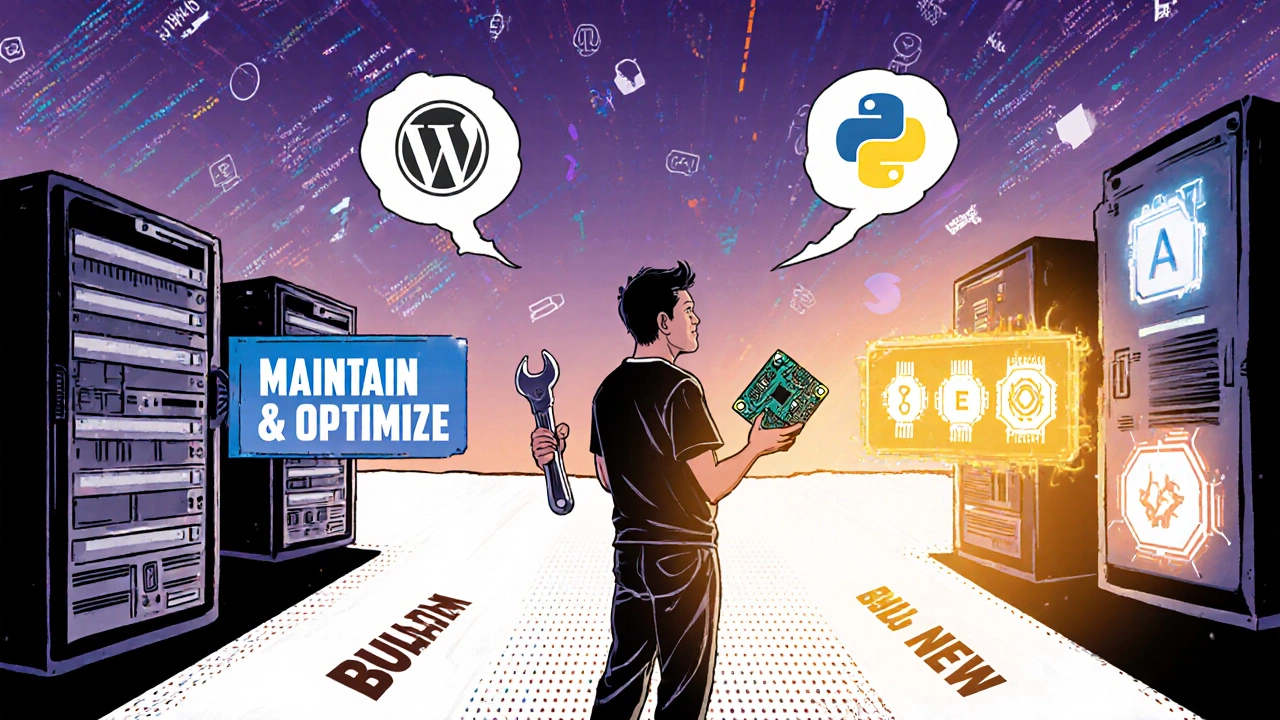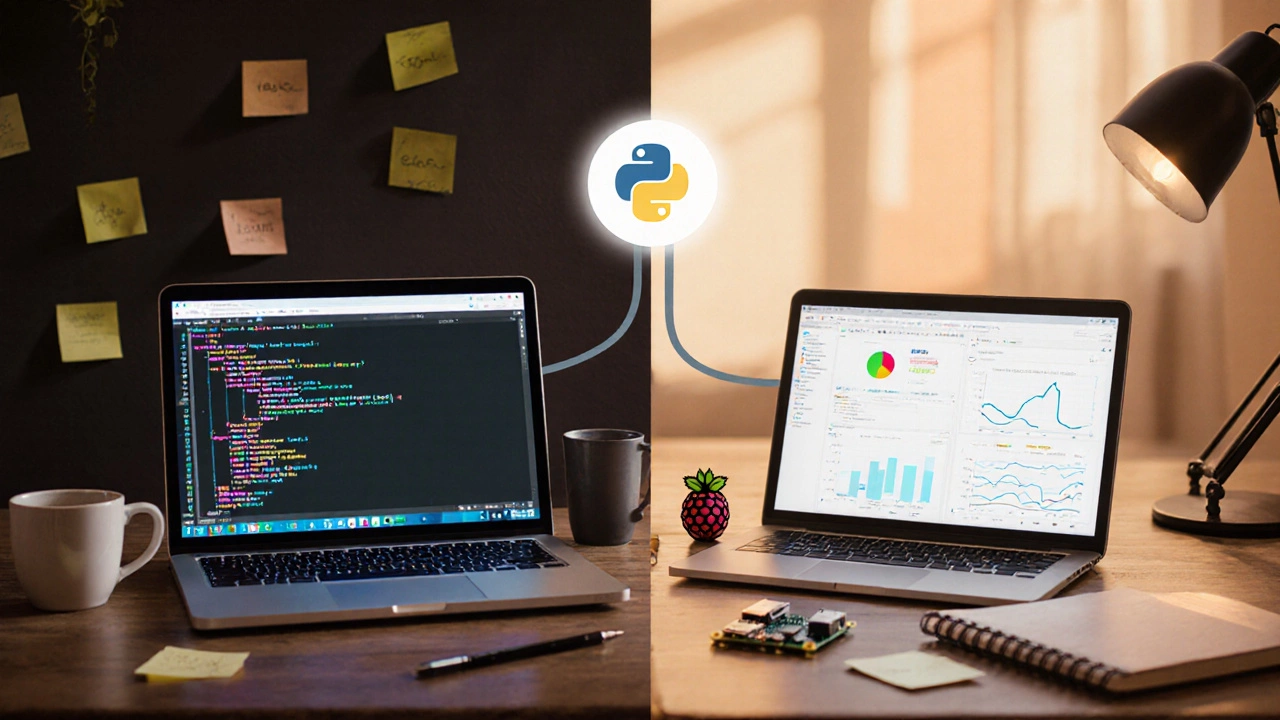PHP vs Python Decision Tool
Project Requirements Assessment
For years, PHP ran the web. WordPress, Facebook, Wikipedia - they all started with it. But now, every new startup talks about Python. Django. FastAPI. Flask. You hear it everywhere: Python is the future. So is PHP dead? Can it actually be replaced? The answer isn’t about which language is better. It’s about what you’re building, who’s maintaining it, and how long it needs to last.
PHP Still Powers Half the Web
Let’s get one thing straight: PHP isn’t going anywhere. According to W3Techs, as of late 2025, PHP runs on 77% of all websites that use a server-side language. That’s not legacy junk - that’s live, updating, profitable sites. WordPress alone powers over 43% of the entire internet. And WordPress? Built on PHP. You can’t just flip a switch and move millions of sites to Python. The cost, risk, and time make it impossible for most businesses.
PHP isn’t slow. It isn’t broken. PHP 8.2 and 8.3 are fast, secure, and packed with features. Type declarations, JIT compilation, union types - these aren’t afterthoughts. They’re modern tools built into a language that’s been evolving quietly for over a decade. Many small businesses still choose PHP because it’s cheap, easy to deploy, and there are thousands of developers who know it.
Why Python Feels Like the Future
Python’s rise isn’t magic. It’s practical. If you’re building something new - a SaaS app, an API, a data-heavy dashboard - Python gives you a head start. Libraries like Django and FastAPI let you go from idea to working prototype in days, not weeks. Need to connect to a database? Django ORM handles it. Need to serve JSON? FastAPI auto-generates documentation. Need to run machine learning on user data? Python has TensorFlow, scikit-learn, and PyTorch built right in.
Compare that to PHP. You can do all of that - Laravel has Eloquent, Symfony has APIs, and there are PHP ML libraries - but you’ll spend more time wiring things together. Python’s ecosystem is tighter. The community is more focused on modern development patterns. You don’t need to hunt for the right package. You just pip install it and go.
Who’s Really Choosing What?
It’s not about language superiority. It’s about team size and project goals.
- If you’re a solo developer building a simple blog or small business site? PHP with WordPress is faster, cheaper, and easier. You don’t need to write code from scratch. Just pick a theme, install a plugin, and you’re live.
- If you’re a startup with 3 engineers and plans to scale to 100k users? Python with Django or FastAPI gives you cleaner code, better testing tools, and easier onboarding for new devs.
- If you’re maintaining a 10-year-old e-commerce platform built on PHP? Don’t rewrite it. Fix bugs, update security, and add caching. Rewriting in Python could cost $200k and take 18 months - and you’ll still lose customers during the transition.
Real-world example: A UK-based online retailer switched from PHP to Python in 2023. Their goal? To integrate real-time inventory syncing with their warehouse robots. The old PHP system couldn’t handle the data flow. They rebuilt the backend in Python with FastAPI and Redis. Result? 40% faster order processing. But they kept their product catalog and checkout - still on PHP - because it worked fine.

The Developer Talent Gap
Here’s the hidden cost: hiring. In 2025, there are more Python developers than PHP developers in the UK. LinkedIn data shows Python job postings grew 62% from 2022 to 2025. PHP postings? Down 18%. That means if you need to hire a new dev, Python gives you more candidates. And those candidates often come with experience in cloud tools, APIs, and automation - skills PHP devs rarely have unless they learned them on their own.
But here’s the flip side: PHP devs are cheaper. And they’re everywhere. In Eastern Europe, India, and Latin America, PHP talent is abundant and costs 30-50% less than Python devs with similar experience. If you’re bootstrapping or running a lean team, PHP still wins on cost.
When PHP Makes More Sense
Don’t write off PHP just because it’s old. It’s still the best tool for specific jobs:
- WordPress sites - no other language has the plugin ecosystem or theme support.
- Small business websites - hosting is cheaper, setup is one-click, and clients understand it.
- Legacy systems - if it’s running, stable, and profitable, don’t touch it.
- Shared hosting environments - PHP runs on $3/month shared servers. Python usually needs VPS or Docker.
One client in Leeds runs a local directory site with 50,000 listings. It’s on PHP 8.1, hosted on a £5/month VPS. They’ve never had an outage. They don’t need AI or real-time analytics. Why switch? They’d spend £15k to rebuild it - and gain nothing.

When Python Is the Clear Choice
Go with Python when:
- You’re building a new API or microservice - FastAPI is faster and cleaner than any PHP framework.
- You need data analysis, machine learning, or AI features - Python’s libraries are unmatched.
- You want automated testing, CI/CD, and clean codebases - Python’s structure encourages it.
- Your team already uses Python for data or scripting - consistency reduces cognitive load.
A SaaS company in Manchester built their billing system in Python. Why? Because they needed to generate dynamic invoices based on usage data, tax rules, and subscription tiers. In PHP, they’d have needed 5 different libraries and custom SQL queries. In Python, they used Pandas to calculate usage, Django REST Framework to expose the API, and Celery to handle background tasks. One team. One language. One codebase.
The Middle Ground: Hybrid Systems
Most real companies don’t pick one. They use both.
Think of it like a car: you don’t replace the whole engine just because you want a better radio. You upgrade what needs upgrading.
Many companies now run PHP for their frontend (WordPress, Magento) and Python for their backend services - like payment processing, analytics, or AI recommendations. They connect them via REST APIs or message queues. The PHP side handles content and user login. The Python side handles heavy lifting. No rewrite needed. No risk. Just smarter architecture.
This hybrid model is growing fast. In 2025, over 40% of mid-sized web companies use both languages. Not because they had to. But because it made sense.
What’s Next? The Real Answer
PHP won’t be replaced. It’ll be sidelined - slowly, quietly, in the right places. Python isn’t killing PHP. It’s taking over new territory. The web isn’t a battleground. It’s a toolbox.
If you’re starting fresh? Go with Python. It’s easier to learn, easier to scale, and better supported for modern needs.
If you’re maintaining an existing PHP site? Keep it running. Update it. Secure it. Optimize it. There’s no shame in using the right tool for the job - even if that tool is 25 years old.
The question isn’t ‘Can Python replace PHP?’ The real question is: ‘What are you trying to build - and what’s the cheapest, fastest, most reliable way to do it?’
Is PHP still worth learning in 2025?
Yes - if you’re working with WordPress, e-commerce platforms like Magento, or small business websites. PHP is still the backbone of millions of live sites. Learning PHP gives you access to a huge pool of existing projects that need maintenance, updates, and security fixes. You’ll find more freelance gigs in PHP than in Python for basic web work.
Can I use Python with WordPress?
Not directly. WordPress is built on PHP, and its entire plugin and theme system depends on it. You can’t swap out WordPress core for Python. But you can connect Python to WordPress via its REST API. For example, use Python to pull data from WordPress for analytics, or push automated content updates from a Python script. Many companies do this - they keep WordPress for content and use Python for backend automation.
Which is faster: PHP or Python?
PHP 8.3 with JIT compilation is faster than standard Python for serving web pages. But Python with FastAPI (ASGI) can match or beat PHP in API performance, especially under load. Speed isn’t the main difference - it’s developer speed. Python lets you build complex features faster. PHP lets you deploy simple sites faster.
Is Python better for security than PHP?
Neither is inherently more secure. Security depends on how you code. But Python frameworks like Django come with built-in protections against common attacks (CSRF, SQL injection, XSS). PHP requires more manual setup. That’s why many developers feel Python is safer - not because the language is better, but because the frameworks enforce good practices by default.
Should I migrate my PHP site to Python?
Only if you’re adding major new features that Python handles better - like AI, data science, or real-time analytics. Otherwise, it’s a costly, risky move. Most PHP sites can be optimized, cached, and secured to perform well for years. Migration should be a last resort, not a trend.





